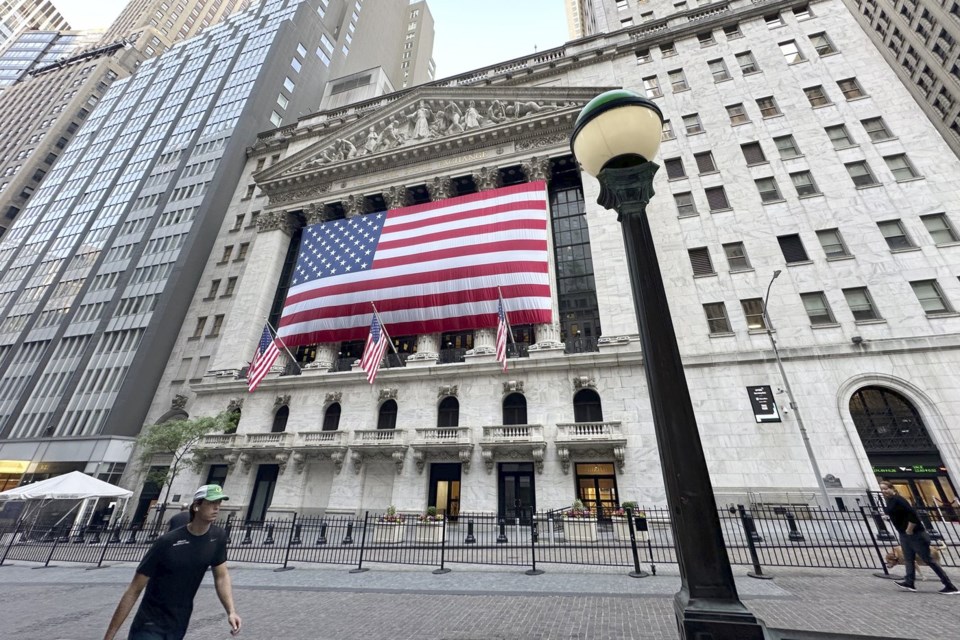Stocks drifted lower on Wall Street, erasing the S&P 500’s gains for the week. The S&P 500 slipped 0.4% Friday, but remains close to the record high it set last week. The Nasdaq composite fell 0.7% and the Dow slipped 0.1%. Nike dropped 20% after the shoe and athletic wear company missed Wall Street’s revenue targets and cut its full-year sales guidance. Company executives said they expect sales to decline by single digits in the current fiscal year, citing a “challenging” environment. Treasury yields were mixed in the bond market after a closely watched report that showed inflation continues easing.
THIS IS A BREAKING NEWS UPDATE. AP’s earlier story follows below.
Stocks on Wall Street gave up early gains and edged lower in afternoon trading Friday, following a closely watched report that showed inflation continues easing.
Investors are hoping that cooling inflation will prompt the Federal Reserve to start cutting interest rates, which remain at their highest level in more than 20 years.
The S&P 500 index was down 0.3%, hovering around its all-time high. The benchmark index remains within striking distance of notching a fourth straight weekly gain. The Nasdaq composite fell 0.3% and is hovering around its all-time high.
The Dow Jones Industrial Average was down 152 points, or 0.4%, as of 3:15 p.m. Eastern.
Consumer prices rose 2.6% in May compared with a year ago, according to the latest personal consumption expenditures index, or PCE. That signaled continued easing from a 2.7% reading in April and is sharply lower than the peak reading of 7.1% two years ago.
“It's moving in the right direction and this is what the Fed needs to make a decision to cut rates,” said Quincy Krosby, chief global strategist for LPL Financial.
The PCE is the Fed’s preferred measure of inflation and the latest reading is encouraging for economists and investors who are hoping for rate cuts to help ease pressure on the market and borrowers. Wall Street is betting that the Fed will start cutting interest rates at its meeting in September.
Treasury yields were mixed in the bond market after initially losing ground following the latest signal of easing inflation. The yield on the 10-year Treasury, which influences interest rates on mortgages and other consumer loans, rose to 4.35% from 4.30% just prior to the release of the PCE data. The yield on the two-year Treasury, which more closely tracks expectations for Fed actions, held steady at 4.72% from just prior to the data's release.
The Fed raised interest rates to their highest level in more than two decades in an effort to tame inflation back to its 2% target. Other measures of inflation, including the well-known consumer price index, have also confirmed that pressure on prices has been easing.
Consumers are still feeling pressure from inflation, despite the significant easing from its peak, and recent data has shown that spending is weakening and weighing down economic growth. The Fed's goal was to slow economic growth enough to cool inflation, but not so much that the economy slips into a recession.
“This combination of inflation coming down and consumers being much more careful with spending patterns allows the market to see the possibility of a rate cut in September,” Krosby said.
The strong jobs market has been another big factor driving economic growth, but that has also shown signs of weakening. Wall Street will get updates on job openings, unemployment, and hiring next week.
Nike tumbled 20.7% for the biggest decline among S&P 500 stocks after the shoe and athletic wear company missed Wall Street's revenue targets and cut its full-year sales guidance. Company executives said they expect sales to decline by single digits in the current fiscal year, citing a “challenging” environment.
Nike's dour outlook dragged other athletic apparel companies down with it. Foot Locker fell 3.5%, Skechers lost 1.2% and Under Armour was down 3.1%.
More retailers, especially those focusing on discretionary items, have been warning about a slowdown in consumer spending. Consumers barely increased spending in May from April, according to the latest government retail sales report.
Gains in technology and financial sector stocks helped limit the pullback in the S&P 500. Salesforce rose 2% and JPMorgan Chase rose 1.3%.
___
AP Business Writers Yuri Kageyama and Matt Ott contributed to this report.
Damian J. Troise And Alex Veiga, The Associated Press



